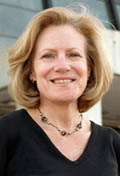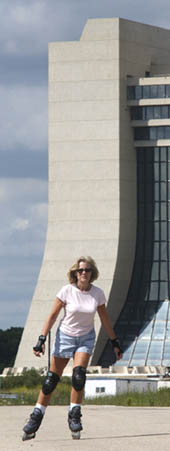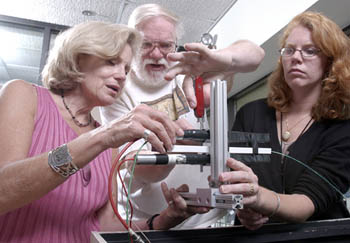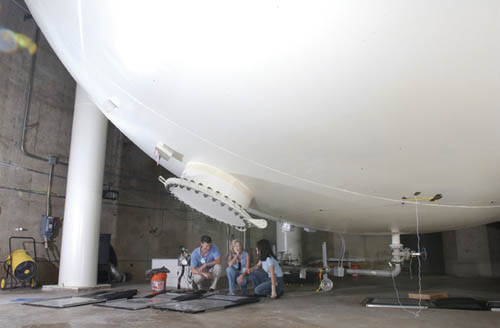 |
|
By-Line from the Frontlines by Matthew Hutson
These are not words you would expect to hear from a newspaper science reporter. And yet I heard them. "It just doesn't happen that way," K.C. Cole continued. "You need to get good statistics—it takes a long time. It's a very, very slow process and you can't say at any particular point 'We found it!'" The process of science—the building of instruments, analysis of raw data, debugging of computer code, cleaning of lenses—usually doesn't make it to the headlines. You hear "Scientists Find Top Quark," but never, "Scientists Find New Use for Mylar Tape." Experimental physicists know better than anyone the tangled marriage of serendipity and tedium in nailing down a discovery. And K.C. Cole, science writer for the LA Times and author, most recently, of Mind Over Matter: Conversations with the Cosmos, thought that as a representative for these blistered folk she should understand the relationship too. So for two and a half weeks this summer, Cole became an experimental physicist at Fermilab. You may remember Cole from her June article in The New Yorker about MiniBooNE. The New Yorker frequently prints long articles about science, but this was the first time in recent memory that the literary institution has printed a story on experimental physics. (The more regular contributors tend not to offer much opinion on neutrino oscillations.) After helping with the story, Columbia's Janet Conrad, a consummate teacher, invited Cole to spend the summer at Fermilab. In a surprising move, Cole's editor in LA liked the idea enough to send her here for half a month.
Cole's editor, of course, expected a significant article when she got back, but Cole had more in mind than just an article. While at Fermilab, she acted not as a science writer trying to get a story but as a scientist, working in the trenches of experiment. You could call this approach embedded science journalism, with obvious reference to the reporters on the front lines in Iraq, but, unlike those reporters, Cole took a direct role in the action. Most project directors wouldn't want a newbie on the scene as more than a spectator, but Conrad offered Cole that responsibility. Len Bugel of Vermont's Stratton Mountain School, one of Conrad's collaborators, had a couple of small projects in mind in the New Muon Lab where Cole could make a contribution in the short time she had. Bugel first paired Cole with Hyekyung Clarisse Kim, an undergraduate at Columbia, to work on the cosmic ray detectors under the 800-ton spherical vat of baby oil at the heart of MiniBooNE, or Mini Booster Neutrino Experiment. To distinguish neutrinos passing through the oil from cosmic rays, a "veto" shell surrounds the main "signal" region of the tank. Signals picked up by the veto region in effect veto simultaneous signals picked up inside the signal region. Occasionally, cosmic rays pass all the way through the tank without firing the veto detectors. Paddles of scintillating plastic lie underneath the tank and measure the veto region's inefficiency. Depending on where cosmic rays hit the paddles, experimenters can measure where the inefficiencies are located on the shell. Cole and Kim used black tape to make the scintillators light-proof, then hooked them up to photomultiplier tubes, and finally "plateaud" the PMT's, or calibrated them so that a plot of the signal produced a clean plateau on a computer screen. Cole found this step the most frustrating. "We had to change the voltage in tiny increments and hold everything else steady, and there was always something that went wrong. The oscilloscope wasn't working right, it was plugged into the wrong channel, the phototube was loose and we weren't getting a good connection." When they went to install the paddles, the wires didn't extend far enough, and then the holes in the floor didn't accommodate the equipment. "Every time we got to a point where we thought, 'Now we're finished,' we were never finished." When they did finish, Cole applied her scintillator experience to Bugel's second project. A beam pipe shoots off the Booster, skirts the Main Injector tunnel and directs protons toward the MiniBooNE detector. Before the protons, clustered around the crests of radio waves, reach the detector, they hit a beryllium target and generate a spray of new particles, some of which decay into neutrinos after a "horn" funnels them into a new stream headed for the oil.
Finally, Cole assisted Fermilab's Bonnie Fleming, a red-headed dynamo who, like Conrad, speaks quickly when excited and eagerly explains physics to anyone with an ear and a minute. The project: a prototype of FINeSSE, or Fermilab Intense Neutrino Scattering Scintillator Experiment, a proposed detector that would sit 100 meters from the end of the neutrino beam line. The tiny (10-ton) detector would, among other things, act as a near-detector for MiniBooNE. "This is like a mini-mini-MINOS," says Conrad. Fleming asked Cole to build a small stack of plastic scintillators, hook up the phototube, place the detector in a light-tight box, and plateau the device. "I think she was a little surprised to find out how hard it was to get even what seem like simple things done," recalls Fleming. "How do you fix it, how do you find the problem? It's a process." Fleming reminded Cole that 99 percent of physics is troubleshooting, and that everything takes "at least pi times longer than you think." Morgan Wascko, a MiniBooNE collaborator from Louisiana State University, worked with Cole for a couple of days. "In order to give someone an idea of what it's really like, you don't want to make it all rosy like it's just a brilliant intellectual pursuit at all hours of the day. There's a lot of just hard boring work that goes into it."
In the past, Cole's writing has emphasized the beauty of nature—the prancing grace of the cosmos, the decisive grip of the strong force. She tackles big ideas and trades in metaphors. Cole begins a book describing a gap in physicists' understanding of "nothing" with the following lines: "There is a hole in the universe. "It is not like a hole in a wall where a mouse slips through, solid and crisp and leading from someplace to someplace. It is rather like a hole in the heart, an amorphous and edgeless void." Describing the spectacle of science, Cole's lyrical prose stands lightyears away from its gritty laboratory origins. I asked Cole if, after a week of fixing leaks and troubleshooting equipment, she asked her mentors when the real science begins. "I know that this is the real science," she said. "Science is so much about getting rid of the noise, getting the signal instead of the hay." Describing the work of Beams Division staff—she called them the "beam people"—Cole expressed admiration for their "incredibly intricate choreography. How delicate and fine-tuned that all has to be!" Regarding her own work, Cole wondered at how "discovery hinges on the tiniest details, like did you tape that phototube correctly? My little piece of tape is ultimately part of this grand cosmic quest." Conrad obviously sees the same value in embedded science journalism. "When you see the finished product at a conference, it looks so clean, so neat. It all follows so well, and that's not the way it works at all. It's good for science writers to see the chaos in action." Bugel came up with an analogy related to his passion for sports cars (especially MG's.) Last spring at a racing school he drove 30 laps in a racecar. "While I certainly didn't come out of there a racer, I came out with a whole lot more appreciation for just how much work and how much precision is involved in getting a racecar rapidly around a course." While Cole didn't become an experimental physicist in three weeks, Bugel said, "she came away from here with a much better appreciation for the immensity and the hard work that goes into doing even a simple little measurement." Lacking such an appreciation may lead to distortion in reporting. Describing her previous career as a political reporter, Cole told a Fermilab colloquium audience last year, "the reason I actually went into journalism at all was that I was so appalled at seeing what events were going on in Czechoslovakia or Hungary, and then watching what was written about that in the newspaper, which seemed to have absolutely nothing in common with what I saw." Although Cole doesn't say so explicitly, she seems to believe that giving a skewed view of science, of how we interrogate the world for facts and come to settle on truth, counts as just such an injustice.
COVER PHOTO: Bill Louis, K.C. Cole, and Hyekyung Clarisse Kim working on scintillator paddles for the cosmic ray detector underneath MiniBooNE. - Photo by Fred Ullrich On the Web:
MiniBooNE Experiment
The New Yorker |
| last modified 11/25/2003 email Fermilab |
FRLsDFx9eyfrPXgV
 "There is never, truth be told, news in physics."
"There is never, truth be told, news in physics."


